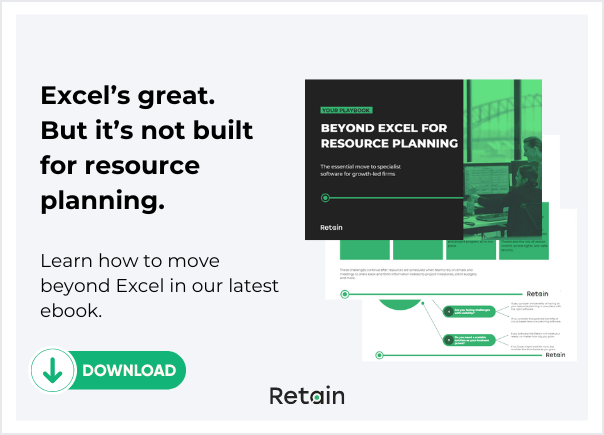When your business is powered by people, effective resource talent management is crucial. The truth is, firms that really nail talent management are the ones that don't just move ahead—they race ahead in the competition.
But getting it right isn't always easy. You need a mix of smart strategies and a sharp eye for dodging common slip-ups.
That’s why we’re delving into the nitty-gritty of resource talent management—including everything from figuring out who you need to hire and when, to making sure your people grow with your firm, and planning for the future.
Technique #1: Strategic workforce planning—Predict future needs
At the heart and centre of top-notch resource talent management is strategic workforce planning. This all starts with digging into what talent you have now and what skills you'll need down the line.
Start by taking a close look at your pipeline and business strategy to see what projects are on the horizon. Then map that back to what your current team can do (skills, capacity, etc). Then play out different scenarios to spot where you might have gaps in your lineup.
By using software, you can ensure you nail down exactly what talent and skills you need to hit your goals. For example, Retain cloud resource management makes the process much easier, helping to identify skills gaps, manage talent, and run ‘what-if’ scenarios.
Key considerations
Watch out for the trap of defining your workforce strategy without considering the bigger business picture. If your approach doesn't connect with your overall business goals, you could end up pretty confused about how your talent choices tie back to what you're trying to achieve.
Plans made in isolation can miss how different skills work together across various parts of your business or in different locations. Putting it bluntly, you might end up putting your time and money into talent strategies that don't quite hit the mark for what your organisation really needs.
Technique #2: Talent acquisition – Attracting the best
Once you've got a clear idea of who you need to hire, talent acquisition steps up to help you bring in those essential skills. It's all about putting together and rolling out a solid sourcing strategy that targets those hard-to-find skill sets out there.
But remember, hiring is not just about ticking off technical skills. It's also about sussing out if someone's a good cultural fit and what transferable skills they bring to your team. Think about the future too. Consider a candidate's potential and how they might grow.
Get creative with where you look for talent. Step out of your usual circles and the same old job boards. Check out some niche spots. It's super important to build a varied talent pipeline—it keeps things fresh and avoids everyone thinking the same way.
Top tip: Start by looking at talent globally, make connections at universities, and don't forget to use contractor databases. Also, don't overlook referral incentives—they can be really valuable.
Key considerations
But here's a heads-up: try not to lean too heavily on referrals from your own team. Relying too much on your internal network can lead to a bit of an echo chamber in thinking. Sure, people you know can give you the lowdown on a candidate's fit and some skills, but they might not have the full picture of their technical abilities. That's why having strong assessment tools in the recruitment process is key, so you can check if they've got the skills you're after.
Technique #3: Talent development – Nurture high-fliers
In the tough competition for the best talent out there, developing your team's skills is key to keeping and growing your talent. It's a real, visible way your organisation shows it's serious about helping employees flourish. This means rolling out a range of strategies.
Think: training programs to sharpen those sought-after skills, mentorship to help navigate career paths, and giving out challenging assignments that prep people for bigger things.
This whole process of in-depth development planning should start early, sometimes right from when you're recruiting. Planning ahead like this means you can line up what your team members want with what your clients and your organisation needs, right from the get-go.
Key considerations
But here's a problem that often comes up: not putting enough into development and keeping your team. When you're always focused on delivering for clients right now, it's easy to lose sight of the importance of building up your team's skills for the future. But the costs of not doing this—like not having leaders ready to step up, taking longer to get good at what you do, or not delivering the best experience to your clients—can slip under the radar.
The fix? Getting the leadership team on board with setting aside the resources and time needed for full-on development programs. And when you're measuring how well these programs are doing, look beyond just the money—think about the quality of the talent they're helping to grow. That way, you make sure you've got a strong, steady stream of talent ready to take your team into the future.
Technique #4: Performance management – Align ambitions and achievements
Effective performance management is super important for making sure employee skills and company goals are in sync. It all kicks off with setting clear expectations, with well-defined goals and benchmarks for success. Having regular catch-ups to chat about how things are going, any challenges, and what support is needed really helps things along.
From here, structured reviews at the end of the year are great for looking at what's been achieved, spotting any gaps, and figuring out what needs more work.
Top tip: A solid review process includes feedback from everyone—managers, coworkers, and even clients. Getting employees to reflect on their own performance is crucial too. Having open discussions about what's worked well and where things might have slipped can lead to real changes in how people work. Giving feedback that's specific and action-oriented helps map out a clear path for growth.
Key considerations
But if there's no transparency, and feedback's just a one-way street, performance management can fall flat. Feedback that lacks context or is only top-down can make employees less engaged and motivated. The trick is to have regular, honest, and straightforward talks that link back to the goals and expectations you've set.
This way, you not only highlight strengths to build on but also point out areas where support is needed, making sure everyone's in the right role. Ultimately, this makes for a workplace culture where high performance and growth are the norms.
Technique #5: Succession planning – Safeguarding the future
Good succession planning is crucial. Why? Because it makes sure you don't miss a beat when it's time for key people to move on. It starts with figuring out which roles are vital, checking out how ready your team is to step up, and making plans to keep the leadership train running smoothly. Plus, thinking about what-if scenarios and having backup plans ready means you're not caught off guard.
Top tip: Being clear about who's up for which big roles, understanding what they need to learn, and customising plans to get them ready are all part of the deal. Quick learning opportunities, like switching roles around, leadership training, and getting a seat at important tables, are great for prepping your next-in-line leaders.
Key considerations
Let's be real: a lot of companies don't get around to this kind of planning. Sometimes it's awkward to talk about people leaving, or everyone's just too busy with day-to-day stuff. The thing is, not being ready for these changes can create major setbacks—especially if someone leaves suddenly or you can't find anyone in-house who's ready to step up. It can greatly impact service delivery and make it hard to keep good people around.
The best move is to spot your rising stars early and give them hands-on experiences to grow. This way, you keep your business running smoothly, hold onto all that valuable knowledge, and open up new opportunities for your best people, making sure your company's future is solid.
Navigating common resource talent management mistakes
We’ve touched on some things to look out for. These are some additional common pitfalls in resource talent management, and how leading professional service businesses work around them.
Mistake 1: Neglecting employee aspirations
One of the biggest oversights in resource talent management is a lack of appreciation for the power of understanding employee’s personal goals and interests. Here’s what we mean by this…
When professionals are consistently assigned to projects that don’t quite align with their career ambitions, engagement and performance suffer. What may seem like optimal resource allocation for project needs, it can come at the expense of motivation, learning, and retention if not balanced thoughtfully with development needs. And this issue grows over time, chipping away at productivity, innovation and trust.
So, prioritise discussions around project and task preferences and then proactively realign roles to meet employees’ needs and desires. This helps boost engagement.
Mistake 2: Deciding resource allocation without data insights
Data is abundant. There’s no excuse not to leverage it in decision-making, rather than relying solely on intuition. Sophisticated analytics on past performance, project outlooks and talent availability provide much-needed insight so you can optimise resource planning.
Without it, you can miss flags or trends that can prevent misaligned skills, capability gaps slowing delivery or even project failure.
Top tip: Just small adjustments informed by analytics create a ripple effect. And the sooner you start using data-driven resource management practices the better.
Mistake 3: Clinging to static resource management
As you know, things never stay the same in this industry and that’s why sticking to traditional or manual methods just doesn't cut it. For example, clients' needs evolving and changes to competitors means your resource management strategies need to be flexible.
Fundamentally, holding on too tightly to old ways of doing things means you might miss out on what's needed right now. It's all about creating a culture that's ready to adapt—one that regularly takes a second look at what you thought was true and tweaks plans as needed.
Top tip: If you’re considering moving from Excel to resource management software, or would benefit from using specialist software you might like this blog. Or you might also enjoy our new ebook.

The bottom line: Sticking with Excel for resource planning means you’ll be stuck trying to make your best guess based on what’s in front of you. It’s not sustainable. In the long term, this is going to hinder growth opportunities and make strategic goals much harder.
Simplify resource talent management
Getting these strategies right is pivotal for shaping a dynamic, high-performing workforce, ready for tomorrow's challenges. But watch out for the common blockers like sticking to static resource management.
The good news: with the right platform, it doesn’t feel like a complete upheaval—instead, you’ll love using the tech while delivering your very best work.
In a world where the right people make all the difference, making sure your team is at their best isn't just a nice-to-have—it's a must. If you want your firm to be a market leader, you've got to be all-in on looking after your most valuable asset: your people.
With a tool like Retain, you can spend less time fixing off-target resource plans and more time adding strategic value.


